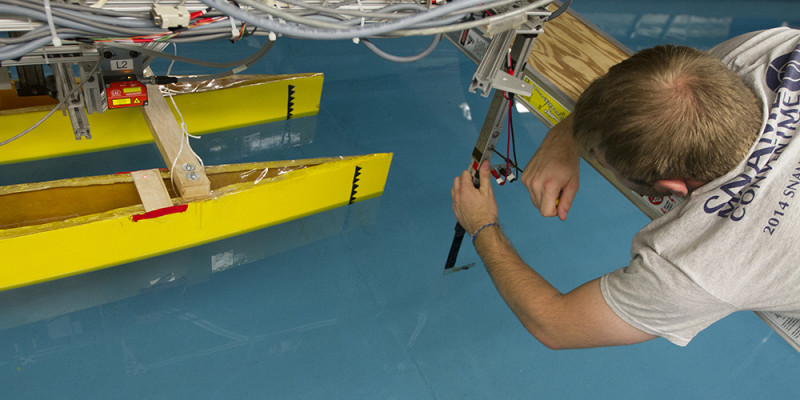
Naval architecture and marine engineering can be described as the design of floating vessels and the integration of their components.
More than 70% of our planet’s surface is covered with water, and our lives are influenced by this fact every day. Whether it’s a large ship carrying cargo across an ocean, a military vessel patrolling the shoreline, a smaller coastal vessel supporting local industries, or a renewable energy device producing offshore electricity, we rely on our water-based industries to support our society.
Using a combination of art and science, naval architects are the lucky individuals who get to design these vessels and determine their shapes and sizes. Using advanced engineering tools and a fine eye for detail, they evaluate the vessels’ stability and maneuvering characteristics, the structures needed to support the forces they’ll experience, and the power needed to propel them through the waves.
Marine engineers are the experts who design the systems that bring these vessels to life. From the largest engine to the smallest part, they’ll determine exactly what is needed to support the vessels’ missions and how best to integrate them within the space available. Like putting a puzzle together, every piece must fit in the right place and nothing can be left out.
Together, naval architects and marine engineers work as a team to design the complete vessel. Imagine that a ship is like a floating city – completely self-sufficient as it crosses the ocean under its own power, producing the power needed to drive the ship, providing the services to support its passengers, and well-engineered to do these things safely and efficiently. Naval architects and marine engineers are the designers and system integrators that make this possible.
What Type of Vessels do Naval Architects Design?
To name a few: cargo ships, high speed sailing and power boats, cruise ships, navy ships, mega yachts, offshore drilling platforms, floating wind turbines, underwater robots, nuclear submarines, and autonomous sailing vessels.
Webb Institute Has a Prescribed Curriculum
All students take the same classes all four years. The subjects are as follows:
Naval Architecture
- Hydrostatics, Hull Form and Stability
- Structural Analysis and Design
- Hydrodynamics, Maneuvering, and Seakeeping
- Resistance and Propulsion
- Design Project
Marine Engineering
- Diesel Engines, Steam, and Gas Turbines
- Auxiliary Machinery and Systems
Engineering and Science Core Requirements
- Electrical Engineering
- Physics, Chemistry, and Materials Science
- Fluid Mechanics and Thermodynamics
- Engineering Drawing and Computer-Aided Drafting
Mathematics and Computer Science
- Calculus and Differential Equations
- Advanced Engineering Mathematics
- Computer Programming and Applications
These course requirements are in addition to core requirements in the humanities, social sciences, technical writing, and oral communication.
Webb Institute is unique in many respects. It offers just one undergraduate program, granting a degree in naval architecture and marine engineering that includes not only a capstone design project, but a senior thesis.
Another unique aspect is Webb Institute’s internship program. Each year during January and February, all students are required to work in the marine industry. Freshmen work in the production departments of shipyards, sophomores go to sea as cadet/observers, and juniors and seniors intern in design and engineering firms. Many of our students intern internationally. Other colleges may encourage students to gain professional experience, but this formally structured program is unique to Webb and a requirement for graduation.
Because few schools teach naval architecture and marine engineering, the supply of naval architects and marine engineers is limited. The placement rate of Webb graduates is 100%. Due to Webb’s practical approach to education our graduates are in great demand, commanding salaries among the top of all engineering disciplines. If you’d like to visit typical corporations that hire Webb graduates, click here.
